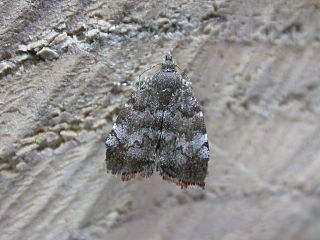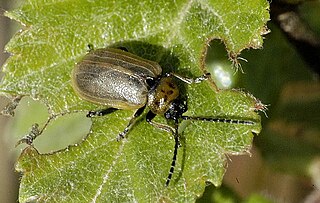
The Japanese beetle is a species of scarab beetle. The adult measures 15 mm (0.6 in) in length and 10 mm (0.4 in) in width, has iridescent copper-colored elytra and a green thorax and head. It is not very destructive in Japan, where it is controlled by natural predators, but in North America, it is a noted pest of about 300 species of plants including rose bushes, grapes, hops, canna, crape myrtles, birch trees, linden trees, and others.

Crataegus, commonly called hawthorn, quickthorn, thornapple, May-tree, whitethorn, or hawberry, is a genus of several hundred species of shrubs and trees in the family Rosaceae, native to temperate regions of the Northern Hemisphere in Europe, Asia, North Africa, and North America. The name "hawthorn" was originally applied to the species native to northern Europe, especially the common hawthorn C. monogyna, and the unmodified name is often so used in Britain and Ireland. The name is now also applied to the entire genus and to the related Asian genus Rhaphiolepis.

The tansy beetle is a species of leaf beetle. It measures 7.7–10.5 mm in length and has a characteristic bright metallic green colouration. The common name derives from the tansy plant on which they often feed as both larvae and adults. In addition to the nominotypical subspecies, which repeats the specific name, C. graminis graminis, there are five further distinct subspecies of tansy beetle, which, collectively, have a Palearctic distribution, although in the majority of countries where it is found the species is declining. In the United Kingdom it is designated as 'Nationally Rare' and this localised population, centred on York, North Yorkshire, has been the subject of much recent research.

Crataegus monogyna, known as common hawthorn, oneseed hawthorn, or single-seeded hawthorn, is a species of flowering plant in the rose family Rosaceae. It is native to Europe, northwest Africa and West Asia but has been introduced in many other parts of the world.

Aporia crataegi, the black-veined white, is a large butterfly of the family Pieridae. A. crataegi is widespread and common. Its range extends from northwest Africa in the west to Transcaucasia and across the Palearctic to Siberia and Japan in the east. In the south, it is found in Turkey, Cyprus, Israel, Lebanon and Syria. It is not present in the British Isles and northern Scandinavia.

The scarlet lily beetle, red lily beetle, or lily leaf beetle, is a leaf beetle that eats the leaves, stem, buds, and flowers, of lilies, fritillaries and other members of the family Liliaceae. It lays its eggs most often on Lilium and Fritillaria species. In the absence of Lilium and Fritillaria species, there are fewer eggs laid and the survival rate of eggs and larvae is reduced. It is now a pest in most temperate climates where lilies are cultivated.

Crataegus laevigata, known as the midland hawthorn, English hawthorn, woodland hawthorn or mayflower, is a species of hawthorn native to western and central Europe, from Great Britain and Spain east to the Czech Republic and Hungary. It is also present in North Africa. The species name is sometimes spelt C. levigata, but the original orthography is C. lævigata.

Lochmaea suturalis, commonly referred to as the heather beetle, is a beetle of the genus Lochmaea native to north-west Europe. It feeds upon heather. They are difficult to spot as they are camouflaged with a brownish colour, and are about 6 millimetres (0.24 in) long. They have a tendency to hide, and they drop into the undergrowth if they are disturbed. They are easier to see when in large numbers on the same plant.

Scythropia crataegella, the hawthorn moth, is a species of moth in the family Plutellidae from western Eurasia. It is usually placed in a small subfamily Scythropiinae, which is sometimes included in the Yponomeutinae of the Yponomeutidae.

Xanthogaleruca luteola, commonly known as the elm-leaf beetle, is a beetle species in the family Chrysomelidae that is native to Europe but invasive in other parts of the world.

Catocala crataegi, the hawthorn underwing or chokeberry underwing, is a moth of the family Erebidae. It is found from Ontario and Quebec to Prince Edward Island south from Maine through Connecticut to Georgia and west to Arkansas and north to Minnesota.

Trichiura crataegi, the pale eggar or pale oak eggar, is a moth of the family Lasiocampidae. It was first described by Carl Linnaeus in his 1758 10th edition of Systema Naturae. It is found in all of Europe, east to Anatolia and east across the Palearctic to Amur.

Dasineura crataegi, the hawthorn button-top gall-midge, is a dipteran gall-midge. It causes the hawthorn button-top gall, which develops in the terminal shoots of common hawthorn, Crataegus monogyna Jacq., Midland hawthorn C laevigata (Poir.) DC and their hybrid, C × media Bechst. Synonyms are Perrisia crataegi and Cecidomyia crataegi.

Smaragdina salicina is a species of short-horned leaf beetles belonging to the family Chrysomelidae, subfamily Clytrinae.

Choreutis pariana, the apple-and-thorn skeletonizer or apple leaf skeletonizer, is a moth of the family Choreutidae. The moth was first described by the Swedish entomologist Carl Alexander Clerck in 1759. It is native to Eurasia and was introduced to New England, USA in 1917.

Galerucella calmariensis is a species of leaf beetle in the family Chrysomelidae. It is commonly known as the black-margined loosestrife beetle and is native to Europe and Asia where both adults and larvae feed on purple loosestrife. It has been introduced in North America as a biological control agent for purple loosestrife.

Cryptocephalus trimaculatus is a species of cylindrical leaf beetles belonging to the family Chrysomelidae, subfamily Cryptocephalinae.

Smaragdina affinis is a species of short-horned leaf beetles belonging to the family Chrysomelidae, subfamily Clytrinae.

Pyronota festiva, commonly known as manuka beetle or manuka chafer, is a member of the genus Pyronota of the beetle family Scarabaeidae. It is a scarab beetle endemic to New Zealand, and is commonly found in manuka trees, hence the beetle's name. In some areas it is considered a pasture pest.

Lochmaea crataegi is a species of leaf beetle native to Europe.




















